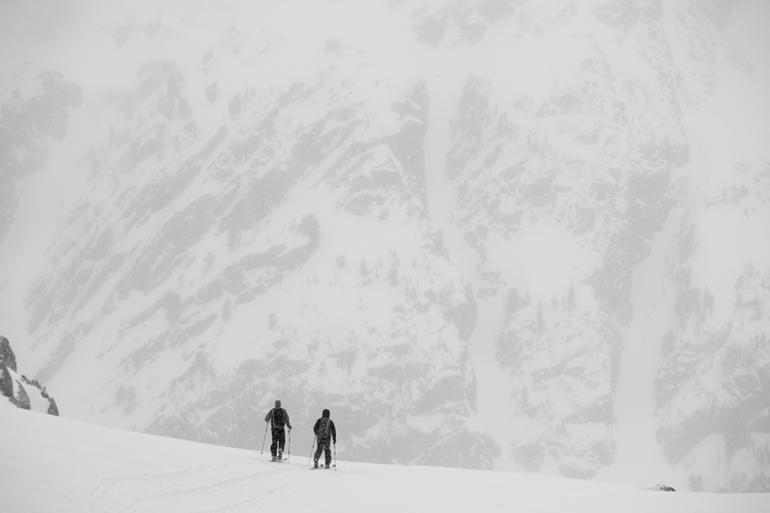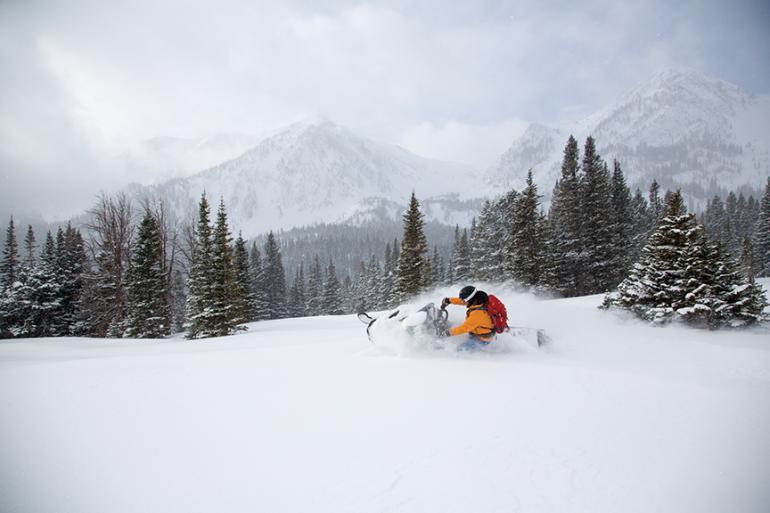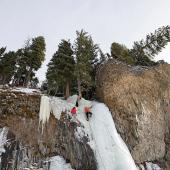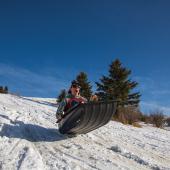Striking a Balance
Imagine a cross-country skier gliding through the backcountry with only the sound of his skis on the groomed trail—a peaceful afternoon in the winter woods. But building like thunder, the whine of engines gets louder until a swarm of snowmobiles slashes through the ski tracks and speeds past him off the trail. For winter trail users, the idea of open-access isn’t always the best option.
But what does closing off motorized access mean? The family of snowmobilers woke up before dawn, loaded their sleds onto the trailer, and set out for an adrenaline-filled day plowing through powder under the winter sun. They arrive at the trailhead to find a right-angle gate blocking their path and a sign announcing that the trail has been closed to motorized use. Their hopes for a fun-filled day are shattered.
Should the motorized users be blocked from exploring Montana’s backcountry, or should skiers and hikers be left with the threat of approaching engines and shattered stillness? There’s no easy answer, and access issues transcend seasons, political affiliations, and land-use designations.
Regardless of what side you find yourself on, snowmobiling has long been a Montana tradition—a way to enjoy the often difficult-to-reach backcountry of our region. With this in mind, Gallatin Valley Snowmobile Association (GVSA) was started in the late 1960s to preserve the sport of snowmobiling and get riders together for group outings. While the club is still in existence today, membership is a far from the numbers of the late 1970s-1980s. (See sidebar.) A change in attitude toward motorized use and ever-increasing restrictions make it difficult to hold the rallies the club once promoted throughout the winter.
Many trails originally traveled by the GVSA have since been closed to motorized use. Most notably is the trail from Bracket Creek to Fairy Lake, first blazed in 1970 by founding members of the GVSA and subsequently closed to snowmobiles due to private-land restrictions.
Trails within the Bozeman city limits are non-motorized, which has been the case since the Main Street to the Mountains trail system was initiated. This means that aside from the occasional unaware cyclist, dog walkers, joggers, and skiers can safely assume they will not have to keep one ear open for an approaching engine—but it also means that people looking to zoom around on their snowmobiles have to travel farther and farther to get their throttle on.
Sharon Harvey, one of the initial members of the GVSA, flips through her spiral-bound book of early club history. She speaks of full-day outings with the snowmobile club, acknowledging that most of those trail excursions are no longer an option. “I think the National Forest could be managed for the people—mountain bikers, skinny skiers, everyone—there’s enough room for all of us out there.”
That perspective on shared use is not unanimous. According to Joe Scalia, former president of the Montana Wilderness Association, shared use has turned into a buzzword that doesn’t carry over to designated Wilderness areas. He says, “There no such thing as shared use on the same [wilderness] land. To experience wilderness in the way advocators experience it is antithetical to motorized noise. That immediately is no longer wilderness—end of story.”
It would be nice to think that all backcountry users can share the trails, but with rising environmental concerns, restrictions will only continue to increase. Engine emissions have gotten cleaner, but when the ban on snowmobiles in Yellowstone was reversed in 2002, according to the EPA, a typical two-stroke snowmobile engine produced as much emissions in seven hours as 100,000 miles in a passenger car.
The expansive Wilderness areas in Montana are one of the allures of our great state, and environmentalists breathe easier knowing that there are indeed tracts of land where the vehicular imprint of man cannot go. That preservation is integral to the health and wellbeing of our planet, but due to the nature of the restrictions, will inevitably block users from the spaces they once enjoyed.
Snowmobiling is a $27 billion industry in the U.S., with the average snowmobiler spending $4,000 annually on the sport. Many small towns bordering Yellowstone National Park depend on revenues earned during the winter months, much of which comes from snowmobile touring in the Park. West Yellowstone and Cooke City are prime examples. In 2001, 65,000 snowmobiles entered Yellowstone, more than half accessing the Park through West Yellowstone.
Winter motorized use in Yellowstone has gotten more stringent over the past several years, with activists attempting to preserve air quality in the Park as much as possible. Snowmobiles entering Yellowstone must meet the Best Available Technology standards for noise and exhaust emissions.
Beginning in Fall 2014, winter motorized entry into the Park will be limited to 50 events per day—an event being one snowcoach or seven snowmobiles. The maximum permitted number will be ten snowmobiles per group, and the limit for commercially guided snowmobiles will be 318 per day. This will undoubtedly have an impact on the economy in entrance towns such as West Yellowstone and Cooke City, as well as for commercial outfitters. While this could cut back on recreational use, these regulations will reduce carbon monoxide and other harmful emissions. Once again, it’s a tossup between a long-revered form of recreation, preserving a precious natural resource, and an economy that depends on winter tourism.
Regardless of the activity or location in question, access issues come back to the increasing number of people looking to share limited space. As Sharon Harvey says, “It’s a people problem. There are too many people who want to do the same thing, use the same areas. We can’t deny them that.” Montanans from all walks will have to make compromises to preserve our natural resources while still giving everyone the chance they deserve to enjoy them.
Information on snowmobiling around Gallatin County can be found at greater-yellowstone.com. For information on winter travel in Yellowstone, visit nps.gov/yell. For updates on wilderness advocacy work, check out wildmontana.org.
A Half-Century of Sledding
The Gallatin Valley Snowmobile Association (GVSA) was formed in 1967 by a group of local residents looking to get together, organize group rides, and promote safe, sustainable snowmobile use around the Gallatin Valley.
The first race was held at the Bozeman Country Club—now the Lindley Center—and boasted over 800 participants. In sharp contrast to current Yellowstone Park regulations, the club’s first organized ride in 1968 took more than 50 riders through the Park to Old Faithful.
1969 saw the inauguration of the Big Sky Trail from Little Bear to West Yellowstone—125 miles long and now nationally registered as a historic trail. In 1970, the GVSA held the Big Sky Governors Cup Race on that trail, with a crowd of 50 snowmobilers in a wild, shotgun start.
The GVSA still holds gatherings, races, and rallies, but with tightening emissions regulations, restricted access, and liability concerns from landowners, it’s increasingly difficult for the club to enjoy the lengthy races and high-volume rallies they once had.
The GVSA is funded through membership dollars and entry fees; the grooming machine is funded through the state gas tax. More information on the GVSA can be found at gvsa.net.
-Maggie Slepian














